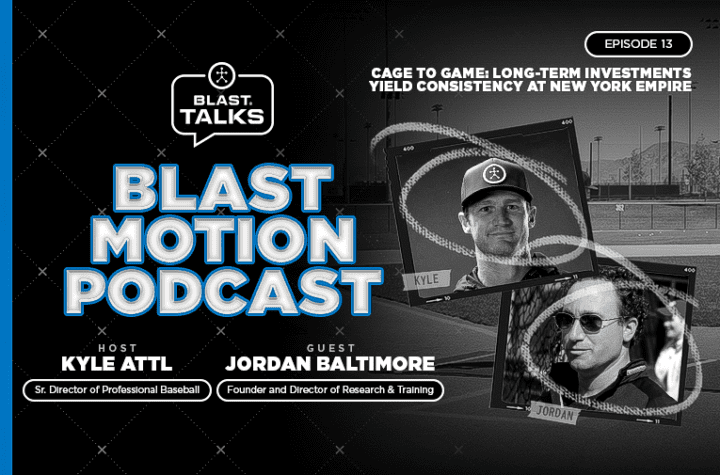
Courtesy of Area Code Games
BY TYLER JONES
I’ve been attending the Area Code Games as an intern for Blast Motion for a few years now, and it’s by far one of my favorite events. When evaluating players at the Area Code Games, I use the player’s Blast Metrics and their performances in the batter’s box to try and connect the dots of what kind of player I think they can be. When a player piques my interest, I do one of two things in my program: circle the name or put a dot next to it.
The players with a circle around their name are the breakout stars – think Mickey Moniak in 2015, Royce Lewis in 2016, and Corbin Carroll in 2018. Everyone had circles around those guys after the Area Code Games.
The guys with dots are guys I think are interesting—Guys who performed well or have good Blast Motion data but still seemed to be under the radar. So I put a dot next to their name and follow them for the rest of the year going into the draft.
Below are some players that got dots next to their names:
________________________________
Collin Mowry – White Sox
Lincoln Way Central HS (IL)
Mowry is currently the 164th-ranked prospect in the nation and 12th-ranked catcher, per Prep Baseball Report. However, based on his performance and his Blast data, I have a strong feeling that Mowry could be getting moved up some people’s lists. He made an immediate impact at ACG by striking the first pitch he saw for a single to left field. Mowry also had an RBI single up the middle with an exit velo of 101 MPH against the Yankees. He reached base in all five games and ended the week with three hits, three RBIs, and one double. He looked comfortable in the box and logged three walks to his two strikeouts.
The Louisville commit produced an average Bat Speed of 74.8 MPH and peaked at 77.6 MPH, highlighting above MLB average Bat Speed. He also logged an average Rotational Acceleration value of 22.4 Gs and peaked at 28.4 Gs – which is also above MLB average. Mowry’s swing contains the prerequisite Bat Speed with the ability to accelerate into that Bat Speed quickly. He also produced an average On-Plane Efficiency above 70%, showing that he’s capable of keeping his bat path on the plane of the incoming pitch for a long time – and if you factor that in with his Bat Speed and Rotational Acceleration values, you get a higher percentage for contact. In terms of how the bat is moving, Mowry has a complete hitting profile, one that’s hard to find for guys who are positioned behind the plate. I expect to hear Mowry’s name get mentioned much more as we get closer to the draft.
________________________________
Zane Becker – Rangers
Flower Mound HS (TX)
The Arkansas commit is currently ranked 213th overall in the nation and the 20th-ranked catcher, per Prep Baseball Report. Zane stood out to us immediately in San Diego. Specifically, it was his Rotational Acceleration metrics. He averaged 19.2 Gs and peaked at 31.4 Gs – which is pretty significant and displays an exceptional ability to accelerate the bat into his peak Bat Speed. However, it’s the Bat Speed that needs work. Zane averaged 65 mph for Bat Speed and peaked at 70 mph. It’s not that his Bat Speed is bad, but Zane would yield tremendous results if he could keep his Bat Speed average above 70 MPH, especially with those RA numbers, and because of that, we think his ceiling for success is really high. Especially since Bat Speed is something we’ve seen improve over a player’s career.
________________________________
David Hogg II – Rangers
Mansfield HS (TX)
Hogg displayed one of the more impressive BP rounds at ACG. When observing his Blast Motion metrics, the LSU commit produced MLB average values in the two most critical metrics for evaluating long-term success – Bat Speed and Rotational Acceleration. His average Bat Speed registered at 72 MPH, and his average Rotational Acceleration was 18 gs. However, what’s really interesting are Hogg’s peak values. Hogg peaked at 80 MPH for Bat Speed and 23.6 Gs for Rotational Acceleration. Those are both far above MLB average.
Because of the variance between the average and the peak values for RA and Bat Speed, one has to think there is a lot more potential in Hogg waiting to be unlocked, or at least more consistently. This could have to do with the inconsistent loading patterns we witnessed on video and in the data. His Early Connection metrics had a variance of 20 degrees, which suggests his hands are starting in multiple places in his load. Finding a more consistent loading pattern could yield better and more consistent results – this is also something he can develop and monitor with a Blast Motion sensor.













